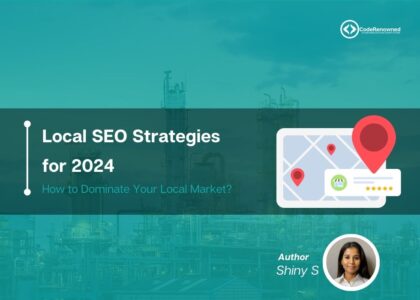Tailored SEO Techniques 2024
Maximize Your Organic Sales Potential With SEO

Introduction:
In Today’s 2024 Digital Era, the primary gateway to information, products, and services is Online presence, essential for businesses and individuals. The amount of content available on the web or simply having a website is not worthwhile. That’s when Search Engine Optimization (SEO) comes into the Game.
What is SEO and its importance for businesses?
SEO is optimizing a website to improve its visibility and ranking on search engine results pages (SERPs) by implementing different techniques and practices wisely. In 2024, SEO Companies aim to attract organic (non-paid) traffic to their website, ultimately increasing their chances of being discovered by users searching for relevant information, products, or services.
- The importance of SEO cannot be exaggerated in today’s competitive online landscape. With millions of websites competing for attention, appearing at the top of search results can significantly impact a website’s traffic, credibility, and bottom line. Studies show that most users don’t look beyond the first page of search results, making it imperative for businesses to rank as high as possible.
- SEO company’s strategies, including keyword research, on-page optimization, technical SEO, link building, and SEO optimized content creation. By understanding how search engines crawl, index, and rank websites, SEO companies can fine-tune to align with search engine algorithms and user intent.
- SEO is not a one-time effort but rather an ongoing process. Search engine algorithms are evolving, and what works today may not be effective tomorrow. Trends, algorithm changes, and best practices are crucial for maintaining and improving a website’s search visibility.
- SEO is about enhancing your website’s relevance, authority, and user experience to make it more attractive to search engines and users. By investing in SEO, businesses can unlock opportunities to expand their online presence, reach the target audience, and achieve business objectives in the digital world.
Below are Some Reasons why SEO is Important For Business:
Increased Visibility: Higher rankings in search engines result in more visibility for the website. The higher the website appears in search results, the more likely users click through to a site.
Targeted Traffic: SEO Companies help businesses attract targeted traffic. By optimizing a website for relevant keywords, One can attract visitors actively searching for products or services they offer. This targeted traffic is more likely to convert into leads or customers.
Credibility and Trust: Websites at the top of search engine results are more credible and trustworthy by users. By ranking high in search results, one can establish the business as an authority in this industry.
Cost-Effectiveness: While paid advertising can drive traffic to your website, it can also be expensive, especially for small businesses with limited budgets. SEO offers a cost-effective way to attract traffic to your site over the long term without continuously paying for ads.
Competitive Advantage: Businesses have an online presence in the Digital era. By investing in SEO, you can stay ahead of competitors and ensure a website stands out in search results.
Improved User Experience: SEO involves optimizing a website’s structure, content, and user experience to make it more accessible and user-friendly. By improving the site’s usability, one can enhance the experience for visitors and increase the likelihood of them engaging with content.
How tailored SEO techniques can help you maximize organic Sales potential?
Tailored SEO techniques specially designed to align with business goals, target audience, and industry to maximize organic sales potential by driving relevant traffic to a website, improving user experience, and ultimately converting visitors into customers. Tailored SEO techniques can play a meaningful role in maximizing organic sales potential for businesses. Here’s how:
Keyword Research and Targeting: Tailoring SEO techniques starts with keyword research to identify the terms and phrases potential customers search for Services or products related to business. By understanding keywords, one can optimize a website’s content, product descriptions, blog posts, and landing pages to align with search intent and attract organic traffic that is more likely to convert into sales.
Optimized Product Pages: Tailored SEO involves optimizing individual product pages visible in search results by optimizing product titles, meta descriptions, and URLs with relevant keywords, providing detailed and unique product descriptions with features and benefits. By ensuring product pages are well-optimized for search engines, one can increase their visibility and drive more organic traffic to online stores.
Content Marketing: Tailored SEO techniques often involve creating high-quality content for the needs, interests, and troubles. These contents are blog posts, articles, guides, videos, or infographics. By consistently producing valuable and relevant content that resonates with the target audience, one can attract organic traffic to their website, build trust and authority, and drive sales through educational content that guides users through the buying process.
Local SEO: For businesses with physical locations or serving specific geographic areas, tailored SEO techniques can focus on optimizing the local search. These include optimizing Google My Business listings, creating location-specific landing pages, and earning positive reviews and citations from local directories. By optimizing for local search, businesses can increase their visibility in local search results, attract customers, and drive foot traffic to brick-and-mortar stores or service areas.
Mobile Optimization: With the increasing usage of mobile devices for online shopping, tailored SEO techniques should also prioritize mobile optimization, which includes ensuring that the website is mobile-friendly, loads quickly on mobile devices, and provides a seamless user experience across different screen sizes. By optimizing for mobile search, businesses can reach customers searching for products or services on their smartphones or tablets and maximize organic sales potential.
Conducting Keyword Research:

Keyword research is the foundation of any successful SEO strategy. It involves identifying specific words and phrases (keywords) for information, products, or services online. The goal of keyword research is to understand the terminology a target audience uses and then optimize the website’s content to increase its visibility in search engine results pages (SERPs).
Below is a step-by-step guide to conducting keyword research effectively:
Define Objectives: Understand the purpose of keyword research. Aiming to increase website traffic, improve search engine rankings, or target specific audience segments?
Understanding Audience: Target audience and understand their needs, interests, and search behavior. Consider demographics, psychographics, and any specific issues or questions they may have related to a niche.
Creative Seed Keywords: Start with a list of broad, general keywords related to the niche. These are often referred to as “seed keywords” and will serve as the foundation for research.
Use Keyword Research Tools: Utilize keyword research tools like Google Keyword Planner, SEMrush, Ahrefs, Moz Keyword Explorer, Ubersuggest, or KeywordTool.io. These tools provide insights into search volume, keyword difficulty, and related keywords.
Analyze Search Volume: View for keywords with a decent search volume. Higher search volume generally indicates a high potential for traffic, but also consider the competition for those keywords.
Assess Keyword Difficulty: Evaluate the competitiveness of each keyword. High competition can make it hard to rank for some keywords, especially if a website is relatively new or lacks authority. Choosing a mix of high- and low-competition keywords can optimize strategy.
Explore Long-Tail Keywords: Long-tail keywords are longer, and specific keyword phrases have lower search volume competition. They can be valuable for targeting niche audiences and capturing more qualified leads.
Consider User Intent: Understand the intent behind each keyword. What are users looking for? Information, products, services, or solutions. Tailor content to match the intent behind the keyword target.
Analyze Competitor Keywords: Research the keywords that competitors are targeting. These can provide valuable insights into SEO strategy and help to identify opportunities to compete.
Regularly Monitor and Update: Keyword research is an ongoing process. Regularly monitor keyword performance, trends, and changes in search behavior and update strategy accordingly.
Tips for finding the right keywords for your business:
Beyond search volume: Search volume won’t solely focus on the most popular keywords. Competition and the user intent behind each keyword are considerable. Long-tail keywords with lower competition and higher user intent can be as valuable as high-volume keywords.
Using keyword research tools creatively: Not relying on the top suggestions from keyword research tools helps to explore keywords, filter by specific categories, and analyze historical trends to find creative keywords.
Think like audience: Immerse in the target audience’s view and brainstorm the questions they might ask or the terms they might use to find your products or services. Use tools like Answer the Public and Google Suggest to see what real people are searching for.
Consider local SEO: If having a local business, incorporate location-specific keywords into your strategy. These include your city, state, and surrounding areas.
Optimize existing content: Review Existing website content and optimize it for relevant keywords. Tools like Yoast SEO or Rank Math can help this process.
Monitor and track results: Keyword research will never be a one-time activity. Tracking keyword performance and adjusting strategy based on results. Tools like Google Analytics monitor organic traffic and see which keywords drive most visitors.
Experiment and be creative: Not scared to experiment with different keywords and content formats. Be surprised at what resonates with the audience.
By following these tips, One can find the keywords that will help businesses attract more qualified leads and achieve their marketing goals.
On-Page Optimization:

On-page optimization is all about making sure your website is search engine friendly. Page optimization, also on-page SEO optimization, refers to optimizing individual web pages to rank and earn more relevant traffic in search engines. It also involves optimizing various elements on a webpage to improve its visibility, relevance, and user experience.
What is Influencer Marketing? Transformation of B2B lead generation By IM :
What on-Page Optimization entails?
Keyword Research and Integration: Identify Relevant keywords that users search for and strategically integrate them into the web page’s content, headings, meta tags, and URLs, helping search engines understand the topic and relevance of the page.
High-Quality Content: Create informative, engaging, and valuable content that satisfies the user’s search intent. Content should be well-structured and provide solutions to users’ queries.
Title Tags and Meta Descriptions: Write compelling and relevant title tags (HTML title element) and meta descriptions (summaries of the page’s content) that describe the page’s content and attract users to click through the search results.
URL Structure: Create user-friendly URLs that are descriptive, short, and include relevant keywords. Clear URLs make it easier for users to understand the page’s topic and improve search engine crawlability.
Headings (H1, H2, etc.): Use proper heading tags (H1 for headings, H2 for subheadings, etc.) to organize content sequence and improve readability. Including keywords in headings can help search engines understand the page’s structure and topic.
Optimized Images: Optimize images by using descriptive filenames, alt attributes, and captions. These help improve accessibility, enhance user experience, and provide additional opportunities for keyword optimization.
Internal Linking: Create a logical internal linking structure within the website to help search engines discover and index other relevant pages. Internal links also distribute link equity (ranking power) throughout the site and improve user navigation.
Mobile-Friendliness: Ensure the website is responsive and mobile-friendly, as mobile usability is a crucial ranking factor for search engines. These involve optimizing design, layout, and functionality for various devices.
Page Speed Optimization: Improve website loading speed by optimizing image sizes, minimizing server response times, using browser caching, and reducing unnecessary code. Faster loading times enhance user experience and can positively impact search engine rankings.
Schema Markup: Implement structured data markup (schema.org) to provide search engines with additional context about the content on the page. These can enhance search engine results with rich snippets like star ratings, reviews, and product information.
Tips for optimizing your website's content, meta tags, and URLs:
Optimizing a website’s content, meta tags, and URLs is determined to improve search engine visibility and user experience. Below are some tips to optimize elements effectively:
Meta Tags Optimization:
- Title Tags: Write unique, descriptive, and compelling title tags for each page, incorporating relevant keywords representing the content. (Characters limit 50 – 60)
- Meta Descriptions: Craft informative and engaging meta descriptions that summarize and entice users to click through to the website from the search results. (Characters limit 155 – 160)
- Meta Keywords: While not as influential, including relevant keywords in the meta keywords tag can still provide some value.
- Canonical Tags: Use canonical tags to specify the preferred version of duplicate or similar content, helping to avoid content issues and consolidate link equity
URL Optimization:
- Descriptive URLs: Use descriptive and keyword-rich URLs that accurately reflect the content, making it easier for users and search engines to understand the page.
- Short and Simple URLs: Keep URLs brief and easy to read, avoiding unnecessary parameters, symbols, or long strings of numbers.
- Hyphens for Word Separation: Use hyphens (-) to separate words in URLs rather than underscores (_) or spaces, as search engines treat hyphens as word separators.
- Avoid Dynamic URLs: When possible, use static URLs instead of dynamic ones, as static URLs tend to be more user-friendly and can be easier for search engines to crawl and index.
Building Quality Backlinks:

Backlinks are the foremost factors in determining your website’s search engine ranking. These are incoming links from one webpage to another website. In simpler terms, when a webpage links to any other page, it creates a backlink.
What is Influencer Marketing? Transformation of B2B lead generation By IM :
What are backlinks, and why are they important?
Backlinks are essential for improving search engine rankings, driving traffic, building credibility, and fostering relationships within the industry. For website owners, it is crucial to focus on acquiring high-quality backlinks from relevant and authoritative source websites to maximize their benefits.
Backlinks are crucial for several reasons:
Search Engine Optimization (SEO): Search engines like Google consider backlinks as votes of confidence. The more high-quality backlinks from reputable sources, the more likely it is to rank higher in search engine results pages (SERPs). Quality matters more than quantity. Backlinks from authoritative and relevant websites carry more weight in boosting a site’s SEO.
Traffic Generation: Backlinks can also generate referral traffic. When a user clicks on a backlink on one website and lands on another, it drives traffic to the linked website. If the referring site has high traffic, it can potentially send visitors to the linked site.
Credibility and Authority: Backlinks from relevant websites can enhance a site’s credibility and authority in its niche. When other trustworthy sites link to your content, it signals to users and search engines.
Relationship Building: Building backlinks involves outreach and relationship-building with other website owners and influencers. These interactions can lead to collaborations, partnerships, and other opportunities that can benefit beyond SEO.
Indexing and Crawling: Backlinks play a role in search engine crawling and indexing. Search engine bots use links to discover new web pages and determine the relationship between different pages. Websites with more backlinks get crawled more frequently, which can lead to faster indexing of new content.
Tips for building quality backlinks to your website:
Building quality backlinks to a website is essential for improving search engine ranking and increasing its visibility. Here are some tips for high-quality backlinks:
Create High-Quality Content: Produce valuable, informative, and engaging content that other websites want to link. These could include blog posts, infographics, videos, case studies, etc.
Guest Blogging: Write guest posts for reputable websites in the industry. Make sure your guest posts are well-written and provide value to the readers. Most guest blogging opportunities allow you to include a backlink to your website in the author bio or within the content itself.
Broken Link Building: Find broken links on other websites within the niche and offer content as a replacement. These are win-win situations for both parties – the website owner gets a replacement link and a valuable backlink.
Build Relationships: Networking with other website owners, bloggers, and influencers in the industry can lead to backlink opportunities. Engage with them on social media, attend industry events, and participate in online forums or communities.
Utilize Social Media: Content Sharing on social media platforms increases its visibility and encourages others to link to it. Social media links may not have as much SEO value as traditional backlinks, which can still drive traffic to the website and attract attention from potential linkers.
Submit to Directories: Submit website to reputable online directories and review sites relevant to the industry. Choose directories that have high domain authority and a good reputation.
Create Linkable Assets: Develop linkable assets like industry reports, whitepapers, comprehensive guides, or tools websites want to link to as a valuable resource.
Participate in HARO (Help a Reporter Out): Sign up for HARO and respond to relevant queries from journalists and bloggers. If your response gets featured in an article, you’ll often receive a backlink to your website.
Monitor Your Competitors: Competitors backlink profiles help to identify potential link-building opportunities. If they have backlinks from reputable sites, you can try to replicate those links for your website.
Avoid Black Hat Tactics: Avoid purchasing backlinks or participating in link schemes that violate search engine guidelines. While these tactics may provide short-term gains, they can ultimately harm your website’s reputation and lead to penalties from search engines.
Creating High-Quality Content:

Creating high-quality content is essential for both SEO and user experience. High-quality content for SEO improves user experience, establishes authority and trustworthiness, attracts backlinks and social shares, and provides long-term value for keywords and semantic search. Creating valuable, relevant, and well-optimized content can significantly improve a website’s visibility and performance in search engine results pages.
Below are Some reasons:
User Experience: Search engines like Google deliver the best possible user experience. High-quality content satisfies users by providing relevant, informative, and engaging information. When users find what they are looking for on a website, they are likely to stay longer, interact more, and return in the future. This positive user experience sends signals to search engines that your website is valuable, which can improve rankings.
Authority and Trustworthiness: High-quality content expertise, authority, and trustworthiness (E-A-T) are crucial factors in Google’s ranking algorithms. When content is accurate, well-researched, and presented professionally, it establishes the website as a credible source of information within the niche or industry to higher rankings and increased visibility in search results.
Backlinks and Social Shares: Compelling and valuable content is more likely to attract backlinks from other reputable websites and social shares from users. Backlinks are supreme for SEO because they serve as “votes of confidence” from other websites, indicating to search engines that content is worthy of citation. Social shares also help increase content visibility and lead to more traffic and engagement, indirectly impacting SEO performance.
Long-Term Value: High-quality content tends to have lasting value. Evergreen content remains relevant and continues organic traffic and backlinks to attract months or even years. By consistently producing valuable content, one can build a sustainable SEO strategy that generates ongoing traffic and visibility for their website.
Optimized for Keywords and Semantic Search: Well-written content naturally incorporates relevant keywords and phrases that users search for. Search engines also increasingly rely on semantic search, which analyzes the context and intent behind search queries to deliver more accurate results. High-quality content that covers a topic and addresses common questions or concerns is more likely to rank well for a broader range of related keywords and search queries.
Tips for creating engaging and informative content that ranks well in search engines:
Creating engaging and informative content that ranks well in search engines requires factors including relevance, quality, and optimization. Here are some tips to achieve that:
Keyword Research: Research relevant keywords that the audience is likely to search for. Use tools like Google Keyword Planner, SEMrush, or Ahrefs to identify high-volume keywords with moderate to low competition.
Quality Content: Focus on creating high-quality, valuable content that addresses the needs and interests of the target audience. Ensure content is well-researched, accurate, and provides information or solutions to common problems.
Optimize for SEO: Incorporate target keywords throughout content, including title, headings, meta descriptions, and body text. Keyword stuffing can negatively impact user experience and result in penalties from search engines.
Engaging Headlines: Attention-grabbing headlines can communicate the topic and value of content. Power words, numbers, and emotional triggers can entice readers to click through their content.
Create Multimedia Content: Mix content formats by including images, videos, infographics, and other multimedia elements. These enhance the visual appeal of content but also help to cater to different learning styles and preferences.
Compelling Meta Descriptions: Write short and compelling meta descriptions that summarize the content and encourage users to click through to a website.
Internal Linking: Incorporate internal links to other relevant pages or articles on the website. These help to navigate, distribute link equity, and encourage users to explore more of their content.
Mobile Optimization: Website and content should be optimized for mobile devices, as significant web traffic can come from smartphones and tablets. These include using responsive design, optimizing page load times, and creating mobile-friendly content formats.
User Experience (UX): Pay attention to the overall user experience of the website and content. Ensure the site is easy to navigate, loads quickly, and provides a seamless reading experience across different devices.
Promote Your Content: Share content on social media, email newsletters, and other channels to increase visibility and attract more traffic to your website. Encourage readers to share your content with their networks to expand reach.
Monitoring and Analyzing Results:

Monitoring and analyzing your SEO results is crucial for measuring success and improvements. One can identify areas for improvement and implement strategies to enhance the website’s visibility and ranking in search engine results.
Below is a guide to effectively monitor and analyze a website’s SEO performance:
Clear Goals: Before monitoring SEO performance, define specific goals to achieve. These goals include increasing organic traffic, improving keyword rankings, boosting conversion rates, etc.
Use SEO Tools: Utilize SEO tools to track and analyze the website’s performance. Some popular tools include Google Analytics, Google Search Console, SEMrush, Ahrefs, Moz, and more. These tools provide valuable insights into a website’s traffic, keyword rankings, backlinks, and other important SEO metrics.
Track Keyword Rankings: Monitor the rankings of target keywords using SEO tools. Watch how a website ranks for different keywords over time and identify fluctuations in rankings. These help to understand which keywords are driving traffic to the site and identify opportunities for improvement.
Analyze Organic Traffic: Use any analytics tools to track the organic traffic a website receives. Monitor trends in organic traffic and identify any spikes or drops. Analyze which pages have the most organic traffic and optimize them for better performance.
Check On-Page SEO Factors: Assess on-page SEO elements such as title tags, meta descriptions, headings, and URL structures. Ensure it is optimized for relevant keywords and provides valuable content to users. Use tools like Moz’s On-Page Grader or SEMrush’s On-Page SEO Checker to analyze and optimize individual pages.
Evaluate Backlink Profile: SEO is essential to monitor a website’s backlink profile. Use tools like Ahrefs or Moz to analyze your backlinks and identify opportunities to acquire high-quality backlinks from authoritative websites. Check for any toxic or spammy backlinks and deny them if necessary.
Monitor Website Speed and Mobile Friendliness: Page speed and mobile-friendliness are ranking factors for search engines. Speed Insights and Mobile-Friendly Tests to assess the website’s performance. Optimize your website’s speed and mobile responsiveness to provide a better user experience and improve your SEO performance.
Track Conversion Metrics: In addition to monitoring traffic and rankings, track conversion metrics such as click-through rates (CTR), conversion rates, and goal completions. Analyze how your SEO efforts in the website’s conversion funnel and make adjustments to improve conversions.
Competitor Analysis: Check on competitors’ SEO strategies and performance. Use tools like SEMrush or Ahrefs to analyze their keyword rankings, backlink profiles, and overall SEO tactics. Identify areas where one can outperform competitors and capitalize on those opportunities.
Regular Reporting and Optimization: Create regular reports to track the website’s SEO performance and progress towards goals. Review the data regularly and make data-driven optimizations to improve the website’s SEO performance.
Tips for using data to make informed decisions about your SEO strategy:
- Before data analysis, establish clear objectives for SEO strategy. Increasing organic traffic and improved keyword or conversion rates have defined goals that help guide data analysis efforts.
- Utilize tools like Google Analytics, Google Search Console, and third-party SEO platforms to collect and analyze data. These provide valuable insights into website traffic, keyword performance, user behavior, and more.
- Identify and track key performance indicators (KPIs) relevant to SEO goals. These include organic traffic, keyword rankings, click-through rates (CTR), conversion rates, and bounce rates.
- Monitor target keywords by identifying keywords that are driving the most traffic, conversions, and engagement.
- Determine pages on the website driving the most traffic, conversions, and engagement. Optimize these high-impact pages further to maximize their performance and improve overall SEO.
- Regularly check for technical SEO issues that may impact your website’s performance, such as broken links, crawl errors, duplicate content, and site speed issues. Addressing these issues can improve the site’s visibility and user experience.
- Experiment with different SEO strategies, like title tags, meta descriptions, content formats, and internal linking structures, through A/B testing. Analyze the data that produces the best results and optimize accordingly.
- Maintain abreast of updates to search engine algorithms, as they can impact a website’s visibility and rankings. Monitor industry news and resources to adapt SEO strategy accordingly.
- SEO is an ongoing process, so regularly review data and assess performance against goals as needed. Continuously optimize strategy based on insights from data analysis to stay ahead of the competition.
Conclusion:
Recap of the importance of tailored SEO techniques for maximizing organic sales potential is ensuring the website attracts the right audience and optimizing specific keywords and phrases related to products or services. Effective SEO techniques help a website’s higher visibility in search engine results pages (SERPs). This visibility leads to more sales opportunities. Websites that rank higher in search results as more trustworthy and credible. Organic search traffic generated through SEO techniques is more cost-effective in the long run. While paid advertising can provide immediate results, it requires ongoing investment. Tailored SEO techniques focus on building a foundation for sustainable growth by consistently optimizing websites for relevant keywords, creating high-quality content, and improving user experience.
Final thoughts for Improving SEO strategy is not about chasing algorithms; it’s about providing value to the audience and ensuring online presence reflects. SEO is a dynamic field that requires continuous learning and adaptation. As search engines evolve, so does the approach to SEO.
- Call-to-Action starts by auditing the current SEO strategy to identify what’s working well and where to improve using Google Analytics and Google Search Console Tools.
- Content is king in the world of SEO. Create high-quality, relevant content that provides value.
- Optimize SEO for Mobile As the high internet traffic comes from mobile devices. Ensure the website is for mobile users.
- Site speed is a significant factor in both user experience and SEO. A slow-loading website can lead to higher bounce rates and lower search rankings.
- High-quality backlinks from reputable websites to search engines signal your site is trustworthy.
- Utilize Local SEO for a physical location or to serve specific geographic areas, and optimize the website for local search.
- Staying Updated on SEO Trends as it is constantly evolving, with new algorithm updates and trends emerging regularly.
- Regularly monitor and Analyze website’s performance in search results and analyze key metrics such as organic traffic, rankings, and conversions.
By implementing these strategies and staying committed to continuous improvement, businesses can enhance their online visibility, attract organic traffic, and drive business growth through SEO.







